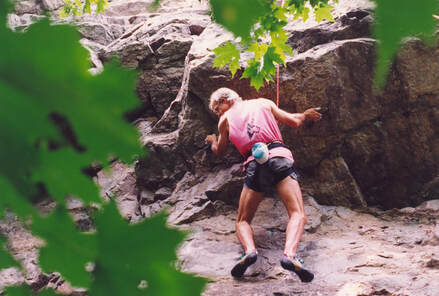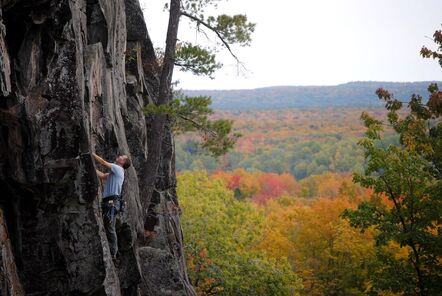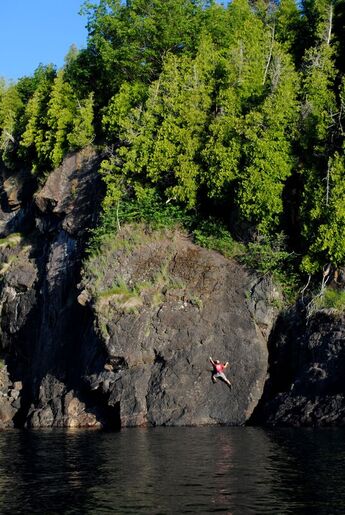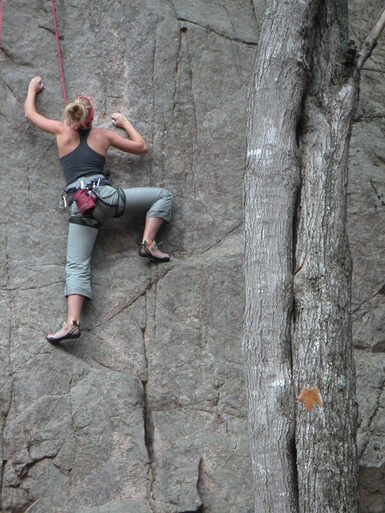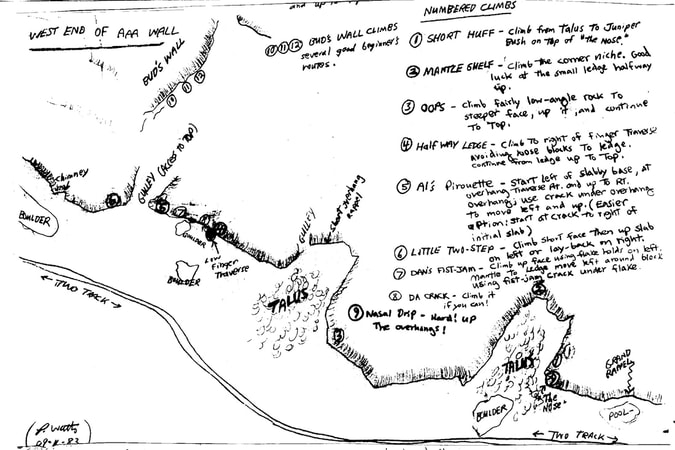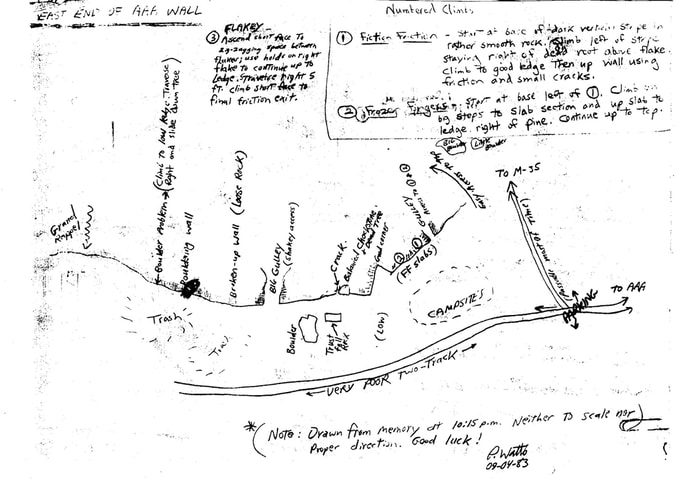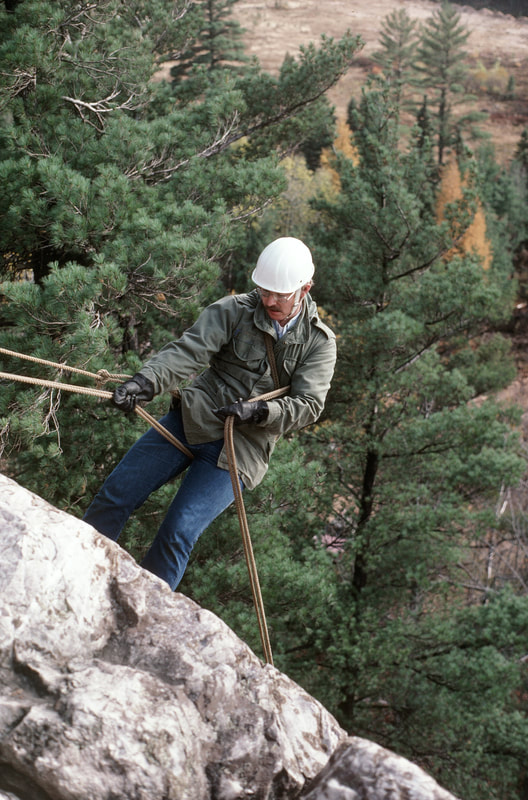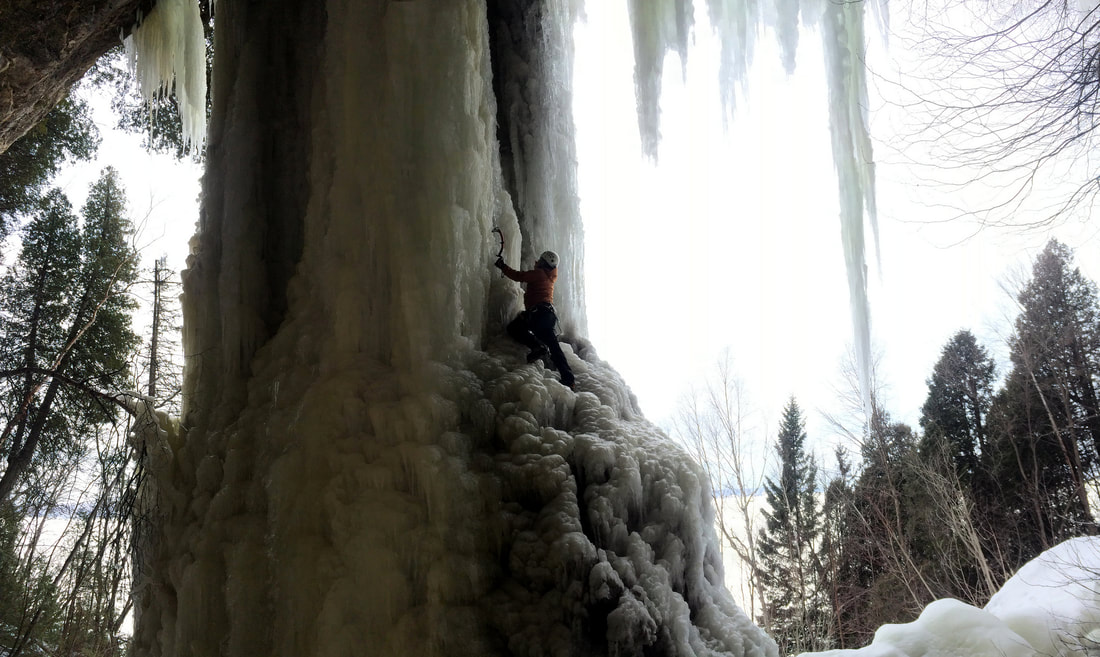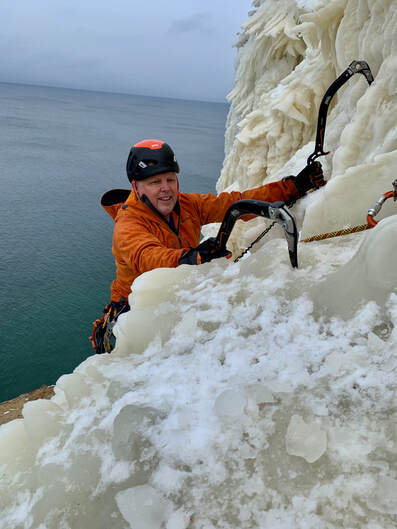The Great Outdoors: The History of Recreation in Marquette County Special Exhibit
|
Bicycling | Birding | Cross Country Skiing | Dog Sled | Downhill Skiing | Guts Frisbee | Ice Skating | Luge | Paddling | Rock & Ice Climbing | Running | Scuba Diving | Ski Jumping | Snowshoe | Trails | Wildlife Photography
|
Rock climbing is done on real rock cliffs and boulders as well as indoors at a climbing gym. Climbing is a social activity with two or more people, using specialized equipment like harnesses, rock shoes, carabineers, quickdraws, cams, and rope. Basic skills in climbing include belaying or holding the rope for another climber as well as rappelling, sliding down a rock face with a fixed rope.
Three common types of climbing:
Traditional Climbing is done by placing and removing gear and is thought to have the least impact on rock faces. Climbers can belay each other up a rock.
Top Rope Climbing is scaling cliffs or artificial walls with a safety rope anchored from above. It is commonly used on indoor climbing gyms and with most beginners outdoors.
Sport Climbing uses preplaced bolts drilled into the rock. It emphasizes gymnastic skill, challenge, and safety.
Climbing in Marquette County
Most of the first places climbers used in the 1970s are still used today: Cliffs Ridge, Presque Isle, the AAA Wall near Big Bay, and ROTC Rock near Tourist Park. ROTC Rock was named for the ROTC army officer training in which they rappel off the rock.
According to Ray Baumgarten, before he attended NMU in 1979, he was told of a few climbing places around Marquette and the Keweenaw when he visited a climbing store in East Lansing. He came up to school, recruited some climbing partners, and explored the rocks he heard about: ROTC Rock near Tourist Park, Cliffs Ridge, and Presque Isle. As he had a bicycle and no car, these nearby rocks were accessible to him.
Marquette is a beautiful and accessible place to climb. "The Pinnacle" at Presque Isle according to Bill Thompson is: one of the most beautiful climbs in the Midwest. Because you get up early, at six o'clock in the morning, you run out there and you're climbing right out of Lake Superior and the sun is rising up out of the lake and it's pretty special and it's really five minutes from anywhere in town. You can do that before work. You can do it after work, and it's easily accessible.
Bill Thompson
Three common types of climbing:
Traditional Climbing is done by placing and removing gear and is thought to have the least impact on rock faces. Climbers can belay each other up a rock.
Top Rope Climbing is scaling cliffs or artificial walls with a safety rope anchored from above. It is commonly used on indoor climbing gyms and with most beginners outdoors.
Sport Climbing uses preplaced bolts drilled into the rock. It emphasizes gymnastic skill, challenge, and safety.
Climbing in Marquette County
Most of the first places climbers used in the 1970s are still used today: Cliffs Ridge, Presque Isle, the AAA Wall near Big Bay, and ROTC Rock near Tourist Park. ROTC Rock was named for the ROTC army officer training in which they rappel off the rock.
According to Ray Baumgarten, before he attended NMU in 1979, he was told of a few climbing places around Marquette and the Keweenaw when he visited a climbing store in East Lansing. He came up to school, recruited some climbing partners, and explored the rocks he heard about: ROTC Rock near Tourist Park, Cliffs Ridge, and Presque Isle. As he had a bicycle and no car, these nearby rocks were accessible to him.
Marquette is a beautiful and accessible place to climb. "The Pinnacle" at Presque Isle according to Bill Thompson is: one of the most beautiful climbs in the Midwest. Because you get up early, at six o'clock in the morning, you run out there and you're climbing right out of Lake Superior and the sun is rising up out of the lake and it's pretty special and it's really five minutes from anywhere in town. You can do that before work. You can do it after work, and it's easily accessible.
Bill Thompson
Phil Watts
Phil and his wife moved to Marquette to teach in 1978. Their plan was to stay for two years then move on. Phil is now retired from NMU but still living locally and climbing. When he came to Marquette there were a few people who climbed and he could see signs of it on the rock. He was introduced to climbing through Michigan State University’s 4H Challenge program in Marquette. Phil taught with the program. There were a few crags around Marquette they would climb, and they found more places to climb.
Phil recalls how the AAA Wall was discovered by climbers: One day a friend, Calvin Thorpe, who had a camp near Big Bay, called to tell him of a rock he found while riding around in his Volkswagen beetle:
‘I found a rock! You might be interested in.’ OK, so another guy in town and myself went up to look at it, meet Calvin to look at this rock, and it was like “WOAH, that is a rock!” and so because it was off the AAA Road, we started referring to it as the AAA Wall. And I started climbing there, with an NMU student at the time. His name was Dan Adsmond. Dan, and we would take members of our 4H Challenge group who were university students, we’d take them out there. And it was pretty primitive climbing--top rope for the most part. Pretty primitive gear, thrashing through the brush to get to the rock. And I'm pretty sure we were the first ones to climb that AAA Wall. Phil Watts
Today many people are introduced to climbing at an indoor gym which helps the sport grow. With better equipment even beginners are attempting more advanced climbs. At the AAA Wall, is a section called Bud’s Wall named after Bud Place, one of its first climbers:
Kids today would probably call it a "boulder" because it was so short. We climbed Bud's Wall. Bud's Wall is a small crag just above the actual AAA Wall. What's called the AAA Wall now is what we repelled down because there's no way anybody could climb that. It was steep, it was overhanging, and so that's what we used to practice repelling. Nowadays there's bolted routes on it and kids are coming out of these climbing gyms and walking right up to those climbs and climbing some pretty stout climbs, which is pretty impressive. Bill Thompson
Other places Phil climbed include Slug's Bluff in Palmer, the Negaunee Slab, ROTC Rock near Tourist Park, and later, Presque Isle.
After several years, Ray and Phil met each other and they showed each other new rocks: Phil introduced Ray to the AAA Wall and Ray introduced Phil to Cliff’s Ridge.
Phil drew this map in 1983 of the AAA Wall.
Phil and his wife moved to Marquette to teach in 1978. Their plan was to stay for two years then move on. Phil is now retired from NMU but still living locally and climbing. When he came to Marquette there were a few people who climbed and he could see signs of it on the rock. He was introduced to climbing through Michigan State University’s 4H Challenge program in Marquette. Phil taught with the program. There were a few crags around Marquette they would climb, and they found more places to climb.
Phil recalls how the AAA Wall was discovered by climbers: One day a friend, Calvin Thorpe, who had a camp near Big Bay, called to tell him of a rock he found while riding around in his Volkswagen beetle:
‘I found a rock! You might be interested in.’ OK, so another guy in town and myself went up to look at it, meet Calvin to look at this rock, and it was like “WOAH, that is a rock!” and so because it was off the AAA Road, we started referring to it as the AAA Wall. And I started climbing there, with an NMU student at the time. His name was Dan Adsmond. Dan, and we would take members of our 4H Challenge group who were university students, we’d take them out there. And it was pretty primitive climbing--top rope for the most part. Pretty primitive gear, thrashing through the brush to get to the rock. And I'm pretty sure we were the first ones to climb that AAA Wall. Phil Watts
Today many people are introduced to climbing at an indoor gym which helps the sport grow. With better equipment even beginners are attempting more advanced climbs. At the AAA Wall, is a section called Bud’s Wall named after Bud Place, one of its first climbers:
Kids today would probably call it a "boulder" because it was so short. We climbed Bud's Wall. Bud's Wall is a small crag just above the actual AAA Wall. What's called the AAA Wall now is what we repelled down because there's no way anybody could climb that. It was steep, it was overhanging, and so that's what we used to practice repelling. Nowadays there's bolted routes on it and kids are coming out of these climbing gyms and walking right up to those climbs and climbing some pretty stout climbs, which is pretty impressive. Bill Thompson
Other places Phil climbed include Slug's Bluff in Palmer, the Negaunee Slab, ROTC Rock near Tourist Park, and later, Presque Isle.
After several years, Ray and Phil met each other and they showed each other new rocks: Phil introduced Ray to the AAA Wall and Ray introduced Phil to Cliff’s Ridge.
Phil drew this map in 1983 of the AAA Wall.
Phil Watts on Finding the Triple A Wall:
Phil is often called the grandfather of climbing in Marquette. He mentored Bill Thompson and many others. Bill explains:
He taught me pretty much everything I know about rock climbing and also introduced me to the sport of ice climbing. And that started back in 1986 and he's still my climbing partner today.
Bill Thompson
Both Phil and Bill emphasize mentors and friends as a vital part of starting and continuing to climb.
Going out on those early morning climbs, when you're all by yourself and when you're with your partner, there's no better way to start the day than a beautiful summer morning in the Upper Peninsula in climbing. Just those times together with your partners. You develop lifelong friendships. That's really important. There's not a lot of activities where you develop these lifelong bonds that keep you together and you still go out on all these really cool adventures. Bill Thompson
He taught me pretty much everything I know about rock climbing and also introduced me to the sport of ice climbing. And that started back in 1986 and he's still my climbing partner today.
Bill Thompson
Both Phil and Bill emphasize mentors and friends as a vital part of starting and continuing to climb.
Going out on those early morning climbs, when you're all by yourself and when you're with your partner, there's no better way to start the day than a beautiful summer morning in the Upper Peninsula in climbing. Just those times together with your partners. You develop lifelong friendships. That's really important. There's not a lot of activities where you develop these lifelong bonds that keep you together and you still go out on all these really cool adventures. Bill Thompson
|
Munising’s sandstone is not good rock climbing; however, Marquette County is a great place to climb, from the city westward. The UP is unlike other parts of the country with thousands of climbs in one location:
In the UP we have hundreds of different climbing areas with two routes up to thirty routes or more. What's nice about that is in this day and age when so many people are climbing, it spreads them out. We can go to any crag on a given Saturday afternoon and have the entire place to ourselves and that's what's really nice. You can go out with your mentor or your climbing partners and have a really good experience and then go back to the campfire and tell all those old stories. Bill Thompson It's a wonderful sport because it's a life sport. You can be six years old and climbing rock and you can be eighty years old and still climbing rock. It's one of those activities that you don't quit after high school. You continue to do it and it takes you to a lot of places around the world. You learn about cultures, you learn about other people's lives, you join their climbing scene, and it's a wonderful activity for anyone of any age to get into. It's very educational. Bill Thompson During these early years, equipment was pretty basic. Climbers wore construction helmets. They first wore hiking boots, then running shoes, then Converse, and finally climbing shoes. Before climbing harnesses were available, they used a swami belt. |
Boy, when we switched from hiking boots and Converse All Star tennis shoes to sticky rubber climbing shoes, it was a game changer. It's been fun to watch the progression of all of the equipment, and the improvements and making it so that you can climb harder and harder climbs now.
Bill Thompson
I was one of the first people if not the first in the county to have a real climbing harness, when we started climbing, we just tied a belt around our waist called a swami belt with tubular webbing, tied the rope into it and off we went. So actually I got a climbing harness, I got that in England, and wore that for quite a while. Phil Watts
Today many people learn to climb at indoor gyms. NMU has had three climbing walls. The first one has built in 1987. A Climbers Co-op offers indoor climbing as well. Some climbers like Phil even have indoor climbing walls in their homes or garages. Phil's is only 10’ x 10’ but has a challenging 62 moves to make.
When Phil began climbing, it was more of a wilderness experience with few people: when we first started going out to the AAA Wall, and even Cliffs Ridge, it was like wilderness adventure, you weren't going to see anybody, there were no trails, sometimes it was difficult to even get a vehicle close, you’d have to hike a distance to get into the rock, and I really enjoyed that, I always enjoyed that, the wilderness solitude feel, at the end of the day, you kinda smell like lichen, it was really good! Phil Watts
Today people can go online to Mountain Project and find places to climb in and around Marquette. More people are climbing these rocks. More recently Phil has met people as far away as Alabama climbing at the AAA Wall. As it became more accessible, it has become more popular.
Bill Thompson
I was one of the first people if not the first in the county to have a real climbing harness, when we started climbing, we just tied a belt around our waist called a swami belt with tubular webbing, tied the rope into it and off we went. So actually I got a climbing harness, I got that in England, and wore that for quite a while. Phil Watts
Today many people learn to climb at indoor gyms. NMU has had three climbing walls. The first one has built in 1987. A Climbers Co-op offers indoor climbing as well. Some climbers like Phil even have indoor climbing walls in their homes or garages. Phil's is only 10’ x 10’ but has a challenging 62 moves to make.
When Phil began climbing, it was more of a wilderness experience with few people: when we first started going out to the AAA Wall, and even Cliffs Ridge, it was like wilderness adventure, you weren't going to see anybody, there were no trails, sometimes it was difficult to even get a vehicle close, you’d have to hike a distance to get into the rock, and I really enjoyed that, I always enjoyed that, the wilderness solitude feel, at the end of the day, you kinda smell like lichen, it was really good! Phil Watts
Today people can go online to Mountain Project and find places to climb in and around Marquette. More people are climbing these rocks. More recently Phil has met people as far away as Alabama climbing at the AAA Wall. As it became more accessible, it has become more popular.
Take a look at these short videos to see some of the climbing equipment on display for this exhibit.
|
|
|
Isn't Climbing Dangerous?
Climbing is usually thought to be dangerous, but it doesn’t have to be:
It's really not an extreme sport. Is it dangerous? It depends. If you're using all the safety precautions, it's actually a pretty safe sport. Can things go wrong? Yes. But I always compare it to other activities that people don't consider extreme sports. Like snowmobiling. I have nothing against snowmobiling, but that's a very dangerous sport. If you ask people between ice climbing, rock climbing, and snowmobiling, what's the most dangerous? They would choose climbing where more people die snowmobiling. So I think if you get the proper training, you use the proper equipment, you take all the safety precautions that it can be a very safe sport to get into. Bill Thompson
Concerns over the dangers involved in climbing have led to limitations from land owners. Phil started Upper Peninsula Climbing Coalition (UPCC) in response to two instances in which climbers were told they couldn’t climb: first at Presque Isle Park, circa 2013 and more recently at the AAA Wall. The national organization, Access Fund, helped secure access at the city park. The founding of UPCC helped cover liability costs at the AAA Wall which is on private property.
Rock climbing in the UP is more limited than more noteworthy places, but it may continue to grow. NMU has a climbing club and some of the climbers enjoy bouldering, which is done on smaller rocks without ropes or gear. Climbers continue to find new rocks to climb.
Bill Thompson
Bill moved to Marquette to attend NMU in 1983 and majored in outdoor recreation. He took the Wilderness Leadership Skills Class where he first met Phil Watts. Phil introduced him to climbing in 1986. Bill is one of the owners of Down Wind Sports, teaches climbing at NMU, organizes the Michigan Ice Climbing Festival and owns a guide service to take people rock or ice climbing.
Climbing is usually thought to be dangerous, but it doesn’t have to be:
It's really not an extreme sport. Is it dangerous? It depends. If you're using all the safety precautions, it's actually a pretty safe sport. Can things go wrong? Yes. But I always compare it to other activities that people don't consider extreme sports. Like snowmobiling. I have nothing against snowmobiling, but that's a very dangerous sport. If you ask people between ice climbing, rock climbing, and snowmobiling, what's the most dangerous? They would choose climbing where more people die snowmobiling. So I think if you get the proper training, you use the proper equipment, you take all the safety precautions that it can be a very safe sport to get into. Bill Thompson
Concerns over the dangers involved in climbing have led to limitations from land owners. Phil started Upper Peninsula Climbing Coalition (UPCC) in response to two instances in which climbers were told they couldn’t climb: first at Presque Isle Park, circa 2013 and more recently at the AAA Wall. The national organization, Access Fund, helped secure access at the city park. The founding of UPCC helped cover liability costs at the AAA Wall which is on private property.
Rock climbing in the UP is more limited than more noteworthy places, but it may continue to grow. NMU has a climbing club and some of the climbers enjoy bouldering, which is done on smaller rocks without ropes or gear. Climbers continue to find new rocks to climb.
Bill Thompson
Bill moved to Marquette to attend NMU in 1983 and majored in outdoor recreation. He took the Wilderness Leadership Skills Class where he first met Phil Watts. Phil introduced him to climbing in 1986. Bill is one of the owners of Down Wind Sports, teaches climbing at NMU, organizes the Michigan Ice Climbing Festival and owns a guide service to take people rock or ice climbing.
Ice Climbing
Climbers climb over frozen seeps or waterfalls. Many rock climbers also ice climb, but not all; the techniques are different as is the temperature.
Ice climbing as recreation started here in the 1970s and 80s at Pictured Rocks. According to Bill Thompson, it began when an ice climber attended a trade show in Chicago where a snowmobile club displayed photos of their trip to Grand Island. After seeing photos of the ice formations, the ice climber came up to try it. Today one might find 50-60 people ice climbing at Pictured Rocks on a weekend.
Local climbers Ray Baumgarten and Kevin Smith ice climbed at Presque Isle, north of town, and on the frozen waterfalls at Pictured Rocks starting in 1979-80. Phil also taught ice climbing and got Bill Thompson started in 1991:
It was at the Eben Ice Caves. This was before Eben Ice Caves were a tourist destination. We went out there with another professor at Northern, John Rebers, and the two of them brought equipment, let us use it and showed us how to do it. It was just another one of those eye opening moments of, "yeah, I really love this" even though it was so hard to do. Bill Thompson
As one can't learn ice climbing in a gym, like rock climbing, one can learn at a festival. Michigan Ice Festival is held in Munising. It brings experienced and new climbers together. The festival is a good opportunity for children and beginners to get a safe introduction.
Climbers climb over frozen seeps or waterfalls. Many rock climbers also ice climb, but not all; the techniques are different as is the temperature.
Ice climbing as recreation started here in the 1970s and 80s at Pictured Rocks. According to Bill Thompson, it began when an ice climber attended a trade show in Chicago where a snowmobile club displayed photos of their trip to Grand Island. After seeing photos of the ice formations, the ice climber came up to try it. Today one might find 50-60 people ice climbing at Pictured Rocks on a weekend.
Local climbers Ray Baumgarten and Kevin Smith ice climbed at Presque Isle, north of town, and on the frozen waterfalls at Pictured Rocks starting in 1979-80. Phil also taught ice climbing and got Bill Thompson started in 1991:
It was at the Eben Ice Caves. This was before Eben Ice Caves were a tourist destination. We went out there with another professor at Northern, John Rebers, and the two of them brought equipment, let us use it and showed us how to do it. It was just another one of those eye opening moments of, "yeah, I really love this" even though it was so hard to do. Bill Thompson
As one can't learn ice climbing in a gym, like rock climbing, one can learn at a festival. Michigan Ice Festival is held in Munising. It brings experienced and new climbers together. The festival is a good opportunity for children and beginners to get a safe introduction.
Thank you to all who contributed photographs to be used in this exhibit. Historic photographs are from the J.M. Longyear Research Library at the MRHC.
